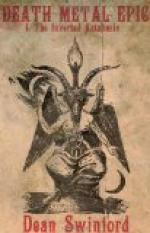The treacherous step-brother now drew cautiously near to ascertain whether Rustem were dead, whereupon our hero begged for his bow and arrows, declaring he wished to ward off the wild beasts as long as he remained alive. The unsuspecting brother, therefore, flung the desired weapons down into the pit, but no sooner were they within reach, than Rustem fitted an arrow to the string, casting such a baleful look at his step-brother that this coward hastened to take refuge behind a tree. No obstacle could, however, balk the righteously angry Rustem, who sent his arrow straight through the trunk into his brother’s heart, thus punishing the murderer for his dastardly trick. Then, returning thanks for having been allowed to avenge his wrongs, Rustem breathed his last beside his faithful steed.
On hearing his son had perished, Zal sent an army to lay Kabul waste, and, having recovered the corpses of Rustem and of his steed, laid them piously to rest in a magnificent tomb in Seistan.
FOOTNOTES:
[Footnote 38: All the quotations in this article taken from the Shah-Nameh are from Champeon’s translation.]
[Footnote 39: It is this part of the story which Matthew Arnold rendered so ably in his “Sohrab and Rustum,” one of his best-known poems.]
[Footnote 40: All the quotations in regard to this episode are from Matthew Arnold’s “Sohrab and Rustum.”]
INDIAN EPICS
Besides the two great classical epics (Mahakavyas)—the Mahabharata and the Ramayana—Indian literature claims eighteen Puranas, each of which bears a distinctive title. These Puranas treat mainly of “ancient legendary lore,” and contain many tales of gods and sages, as well as descriptions of the Hindu world, with Mount Meru as its centre, and also of the deluge.
Many of the incidents of the two great epics inspired later poets to compose what are known as kavyas, or court epics. Six of these by Bahrtruhari are termed Great Court Epics (Mahakavyas), and another, by the poet Acvaghosha, describing the doings of Buddha at length, was translated, into Chinese between 414 and 421 A.D. The Golden Age for the court epics (which were written from 200 B.C. to 1100 A.D.) was during the sixth century of our era.
In the fifth century A.D. the poet Kalidasa composed a nineteen-canto epic, entitled Raghuvamca, wherein he related at length the life of Rama, as well as of Rama’s ancestors and of his twenty-four successors. This poem abounds in striking similes, as does also the same poet’s Kumarasambhava or Birth and Wooing of the War God Siva. There are, however, sundry cantos in all these poems which are too erotic to meet with favor among modern readers. Kalidasa is also the author of an epic in Prakrit, wherein he sings of the building of the bridge between India and Ceylon and of the death of Ravana.




